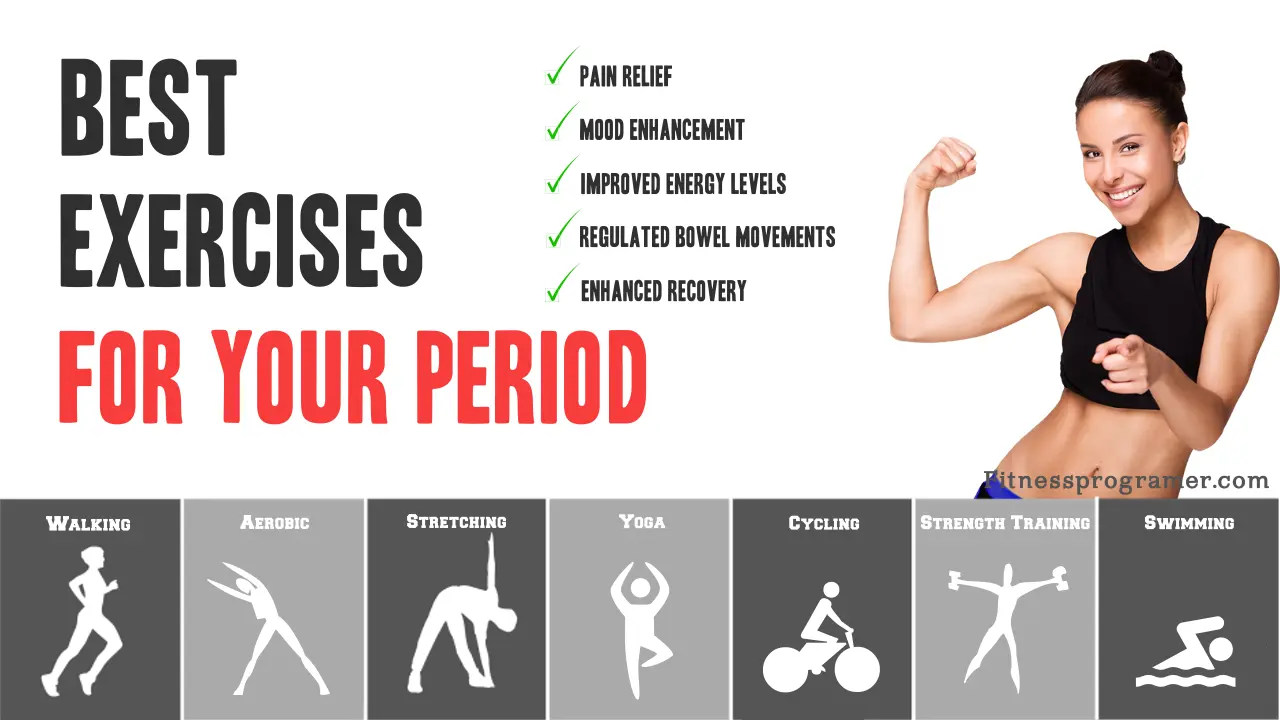Contents
- Understanding Your Menstrual Cycle and Exercise
- Is It Safe to Exercise During Your Period?
- Benefits of Exercising on Your Period
- Best Types of Exercise During Your Period
- Exercises to Avoid (If You’re Experiencing Discomfort)
- Menstrual Cycle-Based Training: A Growing Trend
- When to Rest Instead of Exercise
- How to Stay Comfortable While Exercising on Your Period
- Final Thoughts: Honor Your Body, Period
Every month, many women ask the same question: “Should I exercise while on my period?” The short answer? Yes, you can—and often should. While societal taboos and discomfort can make menstruation feel like a time to rest completely, evidence shows that physical activity during your period can reduce pain, improve mood, and even boost performance depending on the cycle phase.
In this article, we explore the physiological, psychological, and performance-related aspects of exercising during menstruation—what to do, what to avoid, and how to listen to your body during this time.
Understanding Your Menstrual Cycle and Exercise
To understand how exercise affects (and is affected by) your period, it’s helpful to briefly review the phases of the menstrual cycle:
1. Menstrual Phase (Days 1–5)
This is when bleeding occurs, marking the start of the cycle. Hormones—particularly estrogen and progesterone—are at their lowest. Fatigue, cramps, bloating, and mood swings are common.
2. Follicular Phase (Days 6–14)
Estrogen levels begin to rise, and energy levels often increase. Many women feel more motivated and strong during this time, particularly as ovulation approaches.
3. Ovulation (Around Day 14)
A spike in estrogen and luteinizing hormone occurs. Women may feel their strongest here, making it ideal for intense workouts.
4. Luteal Phase (Days 15–28)
Progesterone rises, and estrogen falls. Energy may drop, and PMS symptoms (bloating, cravings, irritability) may appear. Some women experience more fatigue or sluggishness in this phase.
Is It Safe to Exercise During Your Period?
Yes. In general, exercise is safe during menstruation, and research suggests it can even help alleviate common menstrual symptoms such as:
- Cramps (dysmenorrhea)
- Mood swings
- Bloating
- Low energy
According to the American College of Obstetricians and Gynecologists (ACOG), aerobic exercise can improve blood circulation and release endorphins, which act as natural painkillers and mood enhancers.
However, safety depends on individual symptoms. If you’re experiencing severe cramps, heavy bleeding, or fatigue, it’s okay to modify or skip a session altogether. The key is listening to your body.
Benefits of Exercising on Your Period
1. Pain Relief
Exercise releases endorphins that help reduce cramps and improve your pain threshold. Movement also increases blood flow, which can lessen uterine contractions.
2. Mood Enhancement
Due to hormonal fluctuations, mood disturbances are common during menstruation. Regular exercise supports the release of serotonin and dopamine, improving emotional well-being.
3. Improved Energy Levels
Although fatigue is common during menstruation, light-to-moderate activity can boost your overall energy without overstressing your body.
4. Regulated Bowel Movements
Exercise stimulates digestive function, which may help relieve constipation and bloating associated with hormonal changes.
5. Enhanced Recovery
Low-intensity activities such as yoga and walking can promote muscle recovery and flexibility, particularly during days when high performance isn’t feasible.
Best Types of Exercise During Your Period
1. Walking
A brisk 20–30 minute walk can reduce cramps, improve circulation, and lift your mood.
2. Yoga and Stretching
Gentle poses like Child’s Pose, Cat-Cow, and Supine Twists relieve lower back tension, support digestion, and calm the nervous system.
3. Low-Impact Strength Training
If you feel up to it, light strength training (using body weight or light resistance) can maintain strength without overstressing the body.
4. Swimming
Not only is swimming gentle on joints, but the water pressure can temporarily reduce bloating and inflammation.
5. Cycling (Moderate Intensity)
Stationary or light outdoor cycling promotes circulation without excessive joint strain.
Exercises to Avoid (If You’re Experiencing Discomfort)
While there’s no one-size-fits-all rule, you may want to avoid or scale back:
- High-intensity interval training (HIIT)
- Heavy lifting
- Long-distance running
- Inverted yoga poses (like shoulder stands or headstands—some traditions recommend avoiding these during menstruation)
These may increase intra-abdominal pressure or exacerbate fatigue, cramping, or dizziness, especially on Day 1–2.
Menstrual Cycle-Based Training: A Growing Trend
Cycle-syncing workouts—the practice of tailoring your training program to your menstrual cycle—are gaining popularity. Research suggests women may benefit from increasing training volume and intensity during the follicular phase (when estrogen is higher) and focusing on rest, recovery, and lower-intensity work in the luteal and menstrual phases.
Personal trainers and coaches are increasingly offering cycle-aware programming that respects hormonal fluctuations and female physiology.
When to Rest Instead of Exercise
Listen to your body. You might choose rest if you experience:
- Severe cramps or nausea
- Dizziness or light-headedness
- Heavy menstrual flow
- Fatigue not improved by light movement
Skipping a workout is not a failure—it’s part of sustainable fitness. You can always adjust your training plan to include an extra recovery day.
How to Stay Comfortable While Exercising on Your Period
- Wear breathable, dark-colored workout clothes
- Choose high-absorbency tampons, menstrual cups, or period-proof underwear
- Stay hydrated
- Bring extra supplies to the gym (pads, wipes, etc.)
- Warm up thoroughly to reduce stiffness and cramping
Final Thoughts: Honor Your Body, Period
Exercising during your period is not only safe—it can be incredibly beneficial. From pain relief to mental clarity, the right kind of movement can make your cycle more manageable and empowering. The key is to move intuitively, choosing what feels good for your body on any given day.
Fitness is not about pushing through pain—it’s about building a relationship with your body that honors its changing needs, cycle after cycle.
Keywords
- exercising on your period
- menstrual cycle and exercise
- should you work out during your period
- period workout benefits
- best exercises during menstruation
- working out on period
- exercise cramps relief
- menstrual cycle fitness
References
- American College of Obstetricians and Gynecologists (ACOG). (2020). Menstruation in Girls and Adolescents: Using the Menstrual Cycle as a Vital Sign. https://www.acog.org/
- Bruinvels, G., Burden, R., McGregor, A., Ackerman, K., & Pedlar, C. (2017). Sport, exercise and the menstrual cycle: where is the research? British Journal of Sports Medicine, 51(6), 487–488. https://doi.org/10.1136/bjsports-2016-096279
- De Jonge, X. A. (2003). Effects of the menstrual cycle on exercise performance. Sports Medicine, 33(11), 833–851. https://doi.org/10.2165/00007256-200333110-00004
- Sims, S. T., & Heather, L. E. (2016). ROAR: How to Match Your Food and Fitness to Your Unique Female Physiology for Optimum Performance, Great Health, and a Strong, Lean Body for Life. Rodale Books.
- Sung, E., & Han, A. (2020). Menstrual cycle and exercise performance. Sports Medicine – Open, 6(1), 24. https://doi.org/10.1186/s40798-020-00247-8



